The New Omega Speedmaster Chronoscope Collection (Live Pics & Price)
A new take on the Speedmaster, in a new size with a new hand-wound engine and a dial that allows multiple calculations.

Following numerous new models in the Speedmaster collection this year already (incl. the brand new Moonwatch), Omega is adding a new version to the range. A new Speedmaster? Yes, but this one is actually quite special; it comes with many unprecedented features and reintroduces a name that is dear to the brand. So, let’s go straight to the point: here’s the new Omega Speedmaster Chronoscope Collection, a new design, a new size, a new movement, the comeback of the Chronoscope name, a dial that echoes vintage watches from the brand… Let’s have a closer look.
The Comeback of the name Chronoscope
The name Chronoscope isn’t new to Omega. It was used during the mid-2000s in the De Ville collection as a name for its chronograph watches. In fact, it goes much deeper than this, since the first watch named Chronoscope by Louis Brandt (the company that would become Omega) dates back to 1885 – you can see this pocket watch below. But why Chronoscope? This requires a look back at the early days of watchmaking.
The name chronograph, as it is used today by most watchmakers, could well be a disambiguation. Indeed, the graph in the name comes from the ancient greek gráph? that means ‘to write’ in English. Looking at the history of watchmaking, the name was first given to the invention of Nicolas Rieussec, who developed one of the first instruments to record elapsed times. Even though it is widely known that the first instrument to record intervals of time was created by Louis Moinet, Rieussec’s invention was noticeably different from classic watches or clocks in that it had a rotating dial revolving under a fixed hand equipped with an ink reservoir. Nicolas Rieussec’s chronograph literally wrote down elapsed times. Hence the creation of the name chronograph. However, in modern watchmaking, no instrument ‘writes’ the time anymore; our modern chronograph watches display the time on their dials with hands… And with ancient Greek in mind, that would correspond to scope and not graph. Indeed, the word skopos could be translated as ‘to observe’. According to Omega, this means “a device used to accurately determine the duration of a phenomenon“.

Omega revives the Chronoscope name today for a rather special edition of its star chronograph watch with the new Speedmaster Chronoscope collection.
The Omega Speedmaster Chronoscope
What we see here with the new Speedmaster Chronoscope is obviously, on many levels, a new iteration of a Speedy watch. As such, the overall design is familiar, specifically for the case. This means an external bezel with a scale (remember that the Speedy was the first watch with this feature in 1957), a case with an asymmetrical design and twisted lugs, and a raised, box-shape crystal on top.
There are, however, a few new features on this Chronoscope. And the first is the size of the watch. While classic Moonwatch models are all sized at 42mm, and the Automatic/Racing/DSOTM versions come in at 44.25mm, the Omega Speedmaster Chronoscope introduces a new “mid-size” 43mm case. The shape is not novel, and pushers/crown and case bands will feel familiar to Speedy lovers. As with the recently revamped Moonwatch, Omega has worked on the proportions. This means that despite the rather large diameter, lug-to-lug width is contained at 48mm and, since the watch comes with a new hand-wound movement, it is also relatively thin at 12.8mm – in fact, thinner than a Moonwatch. It feels good on the wrist and wears slightly smaller than expected (especially on the bracelet, but more on that later).
The case, at least for six of the seven editions, is made of stainless steel and features the classic combination of brushed surfaces and polished accents on the sides. The raised, fixed bezel is equipped with an anodized aluminium insert, which features a classic tachymetre, the first of the four scales of this Chronoscope watch. The case has a typical “sapphire sandwich” architecture, with a water-resistance of 50 meters (like most Speedmaster watches).
The most noticeable element of the Omega Speedmaster Chronoscope is its dial design and architecture that defines the name of the watch. As said above, its objective is to “accurately determine the duration of a phenomenon”, and for that, it can tell you how fast you are going based on how far you have travelled, but also how far you are from something that is visible and audible and even what your heartbeat rate is. You’ve guessed it; the Chronoscope features the three classic scales of a chronograph: a tachymeter, a telemeter and a pulsometer.
The tachymeter is divided into two scales. The first is a classic one on the bezel to measure speeds from 500 to 60 units (kph, mph) Then comes a secondary scale, on two levels, which is at the centre of the dial and can measure speeds from 60 to 20 units (up to 3 minutes of travel). The two other scales, telemeter and pulsometer, are printed on the inner part of the dial and refer to old Omega chronograph watches from the 1930s-1940s.
The dial is also quite unique to this Speedmaster Chronoscope and doesn’t echo previous models in the range. It has a bi-compax layout with small seconds at 9 o’clock and the classic Omega co-axial counter at 3 o’clock and features indications of the hours and minutes. And, the good news is that there’s no date on this watch. The Chronoscope collection introduces a brand new dial with a stepped profile. The hour chapter ring features thin and nicely designed applied Arabic numerals on top of a concentric pattern. The polished, leaf-shaped hands are also new to this watch.
As for the steel models, there are three different dials available. First is a blue dial with silver counters and silver-coloured hands and indexes, and a matching bezel. Second is a silver dial with tone-on-tone counters, blue accents on hands and indexes and a blue bezel. Finally is a panda edition with a silver dial, black counters and a black bezel.
The new movement, Calibre 9908
Inside the case of the Speedmaster Chronoscope is a new movement, or to be more precise, a new iteration of Omega’s Master Chronometer automatic chronograph. Based on the calibre 9900, this new 9908 movement is a hand-wound version characterized by its new ¾ plate. However, it retains the same column-wheel and vertical clutch architecture. Also, the double-barrel layout used to provide stable torque – and not so much a longer power reserve -, has been maintained. The watch beats at 4Hz and has a comfortable power reserve of 60 hours.
Like all modern Omega movements, this new calibre 9908 features a co-axial escapement, is Master Chronometer-certified and anti-magnetic to impressive levels. The view through the caseback reveals a large bridge decorated with the classic Arabesque stripes radiating from the centre of the balance wheel. The finishing is typical of Omega’s production, clean and pleasant to the eye.
Steel bracelet or leather straps
As mentioned, there are six stainless steel references available in the new Omega Speedmaster Chronoscope collection. Each of the three dials is available either on a leather strap, closed by a pin buckle, or a stainless steel bracelet. The design is identical to that of the new Moonwatch, including the thin clasp with a striped pattern. The bracelet measures 21mm at the lugs and tapers to 16mm at the clasp and has polished mid-links. Like the new Moonwatches, the Chronoscope is protected by a sapphire crystal.
New to this model, the clasp has a micro-adjustment with a push-and-slide mechanism. It allows a few millimetres of adjustment (about 5mm) for hot summer days. Also, as with the new Moonwatch, Omega has created short end-links, which go down very close to the case and hug the wrist. You’ll be surprised but the models on the bracelet actually wear smaller than their equivalent on leather straps.
The Bronze-Gold Omega Speedmaster Chronoscope
In addition to the steel models, and just like the recently introduced Seamaster 300 collection, the Omega Speedmaster Chronoscope collection includes an additional watch made of the brand’s latest proprietary alloy: Bronze-Gold. Certified as a 9k gold alloy, it is made of 50% copper, 37.5% gold, silver for the colour and smaller percentages of gallium (a very rare metal that melts at 30 degrees) and palladium.
The idea behind this alloy is to combine the cool colour of bronze, without the oxidation, with the precious feel of gold. This edition, only available on a leather strap, also comes with a solid bronze dial with opaline silvery sub-dials; its dark brown colour is the result of oxidation. Also, this version has a ceramic insert on the bezel, with the tachymeter scale filled in vintage-coloured enamel. The leaf-shaped hands and Arabic numerals are coloured with a Bronze-Gold PVD coating. The brown leather strap is closed by a polished and sandblasted Bronze-Gold buckle. All other specifications are identical to the steel models, the movement included.
Availability & Price
The Omega Speedmaster Chronoscope collection, with the exception of the Bronze-Gold model, is now available from boutiques and retailers. Prices are CHF 8,300 on a leather strap and CHF 8,600 on a steel bracelet. The Bronze-Gold model is priced at CHF 14,000.
For more details, please visit omegawatches.com.

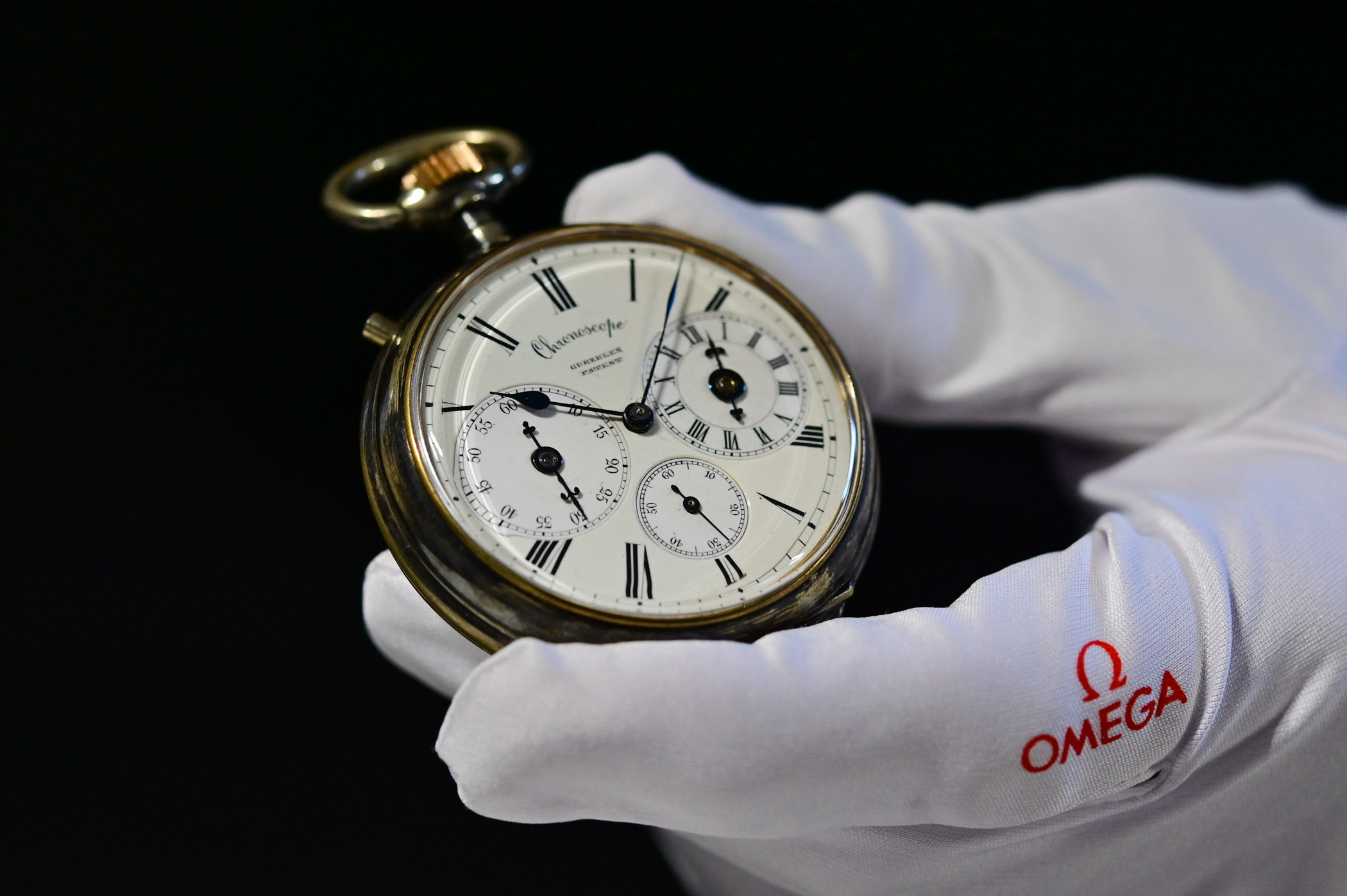

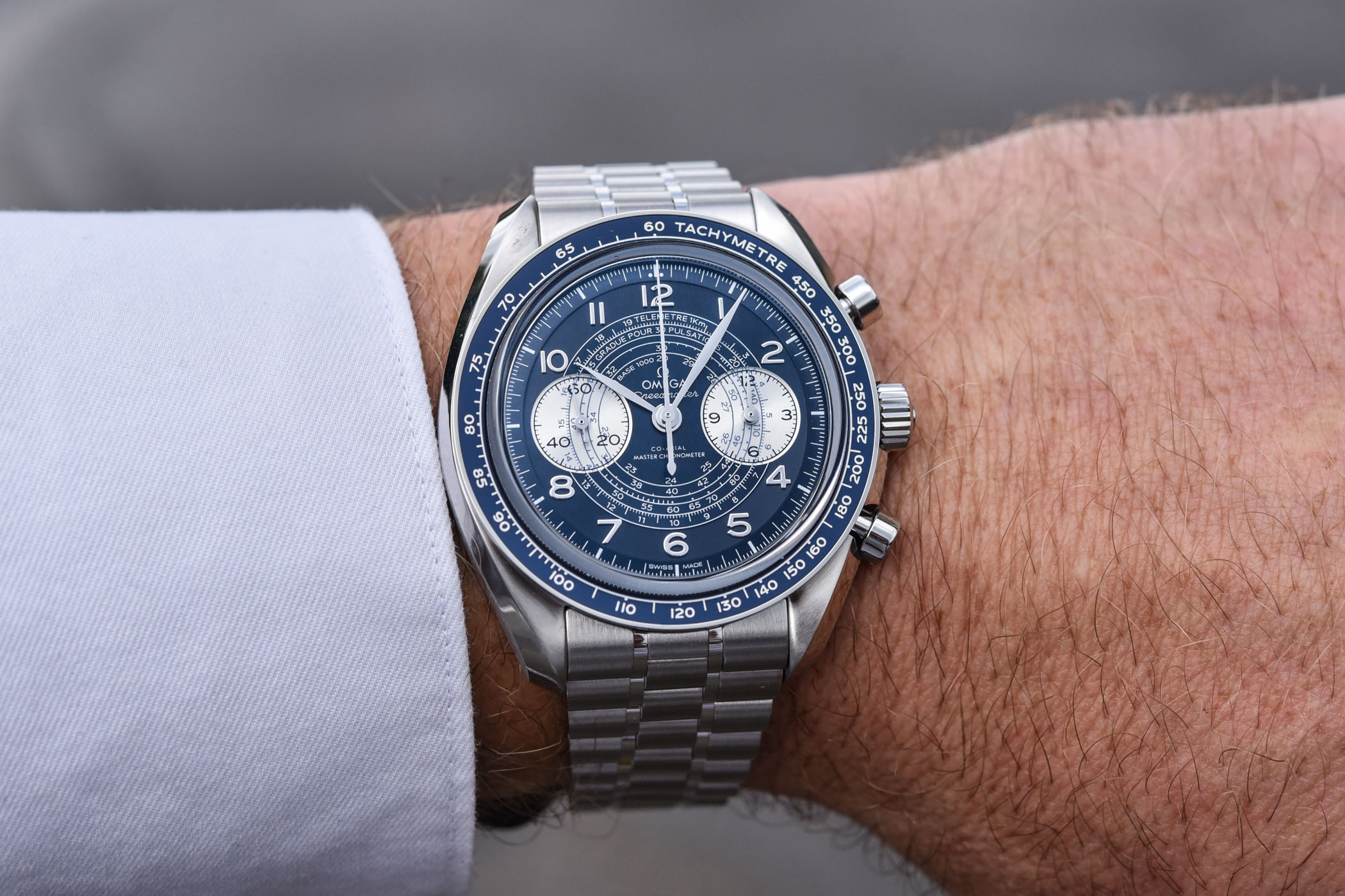
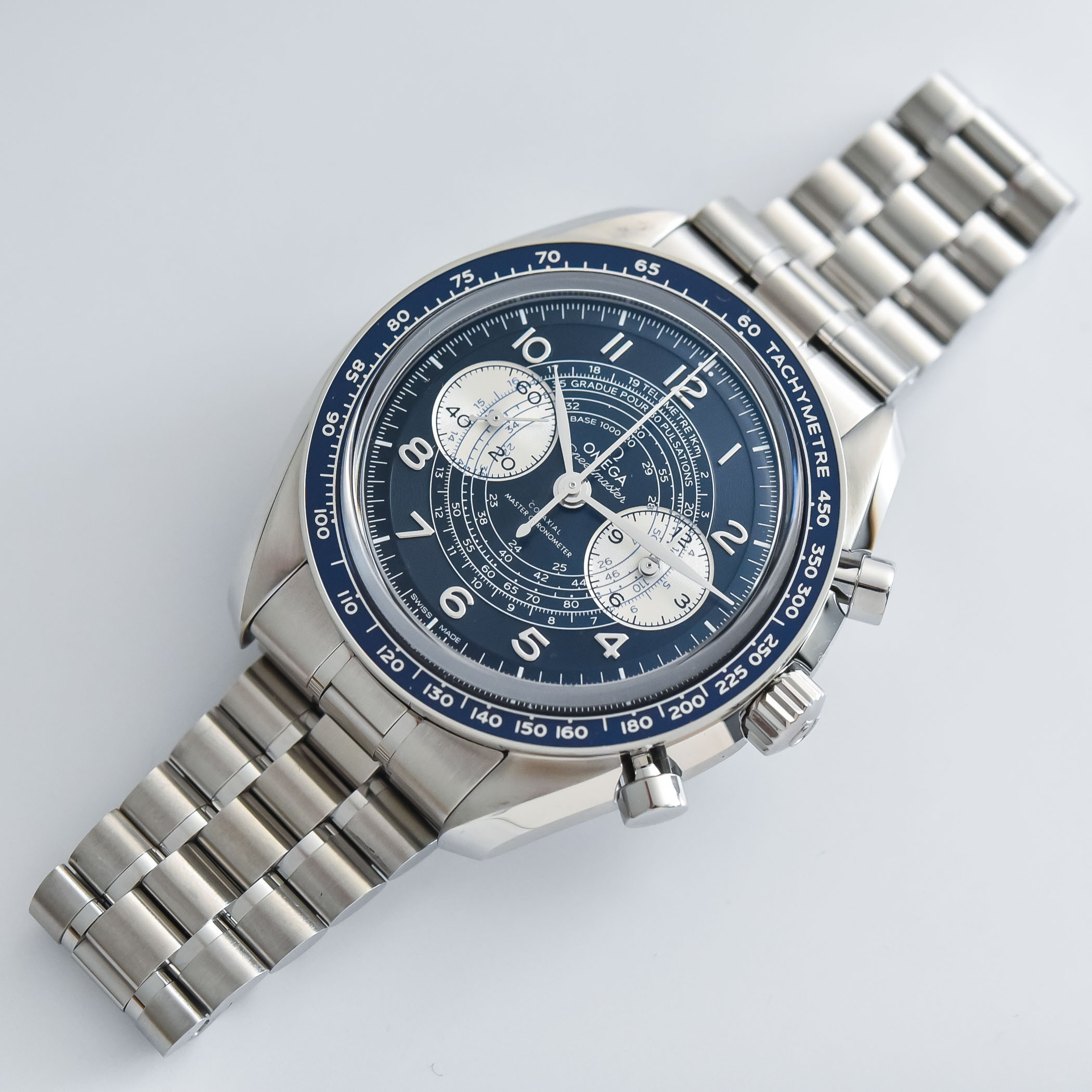
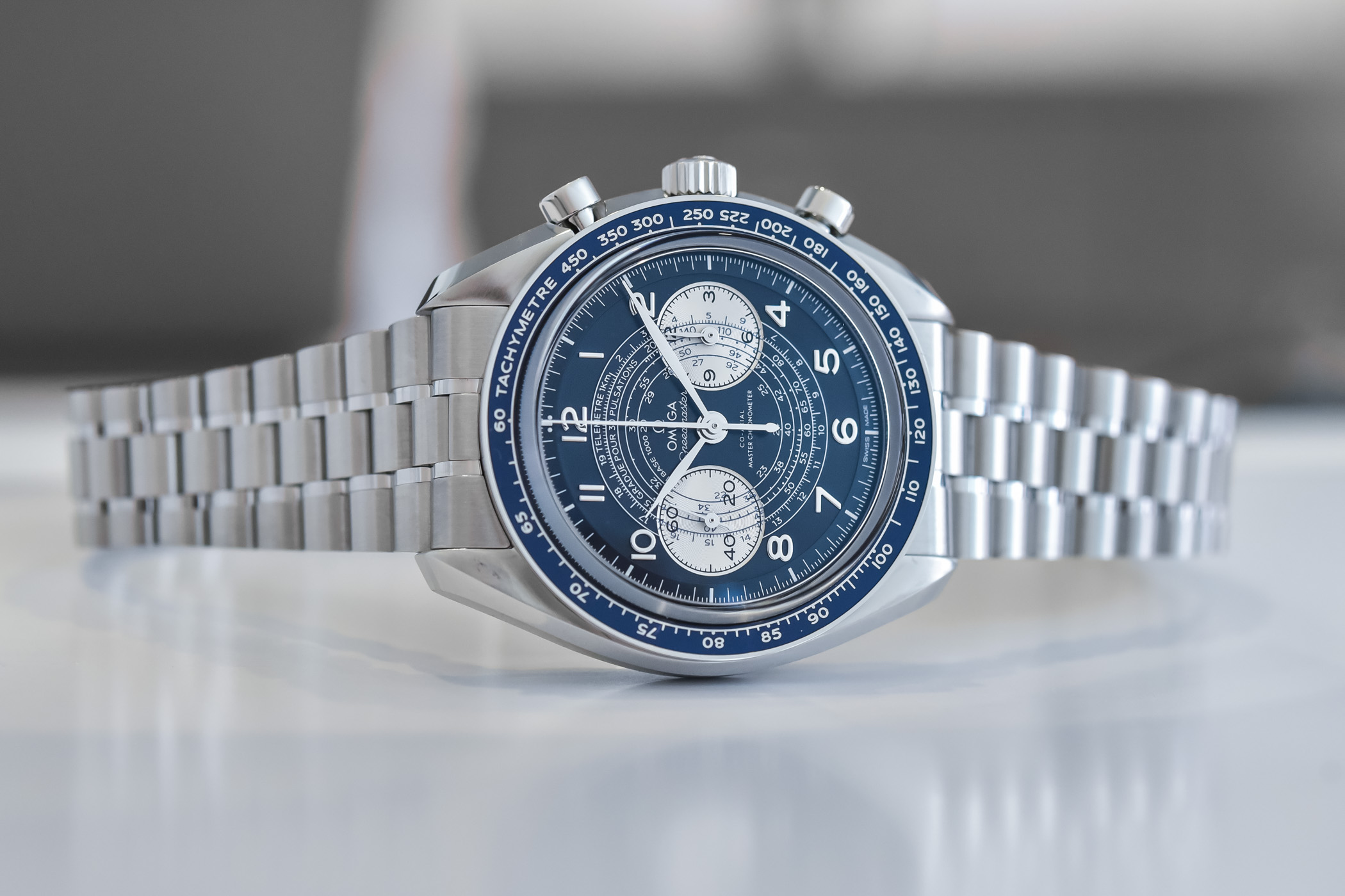
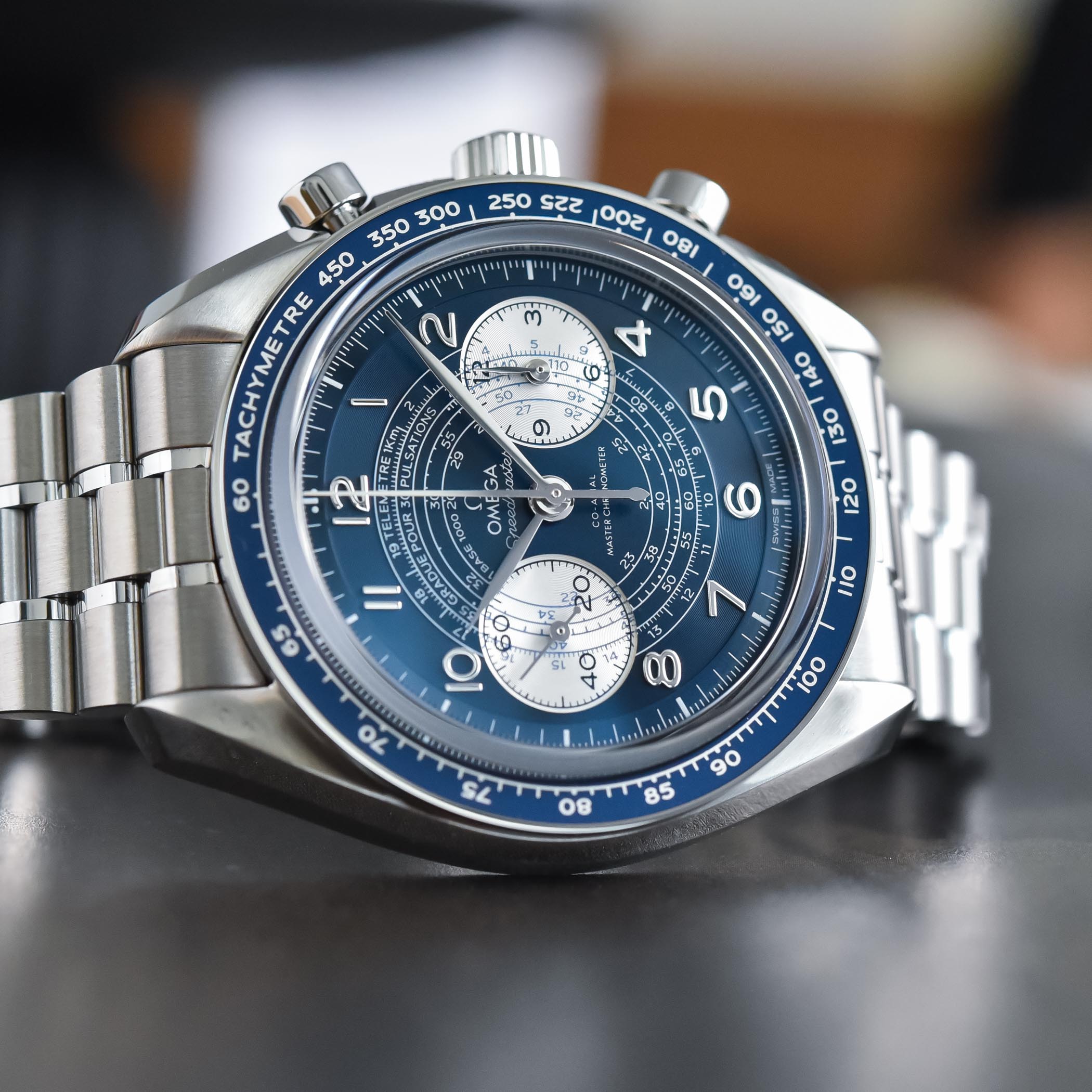
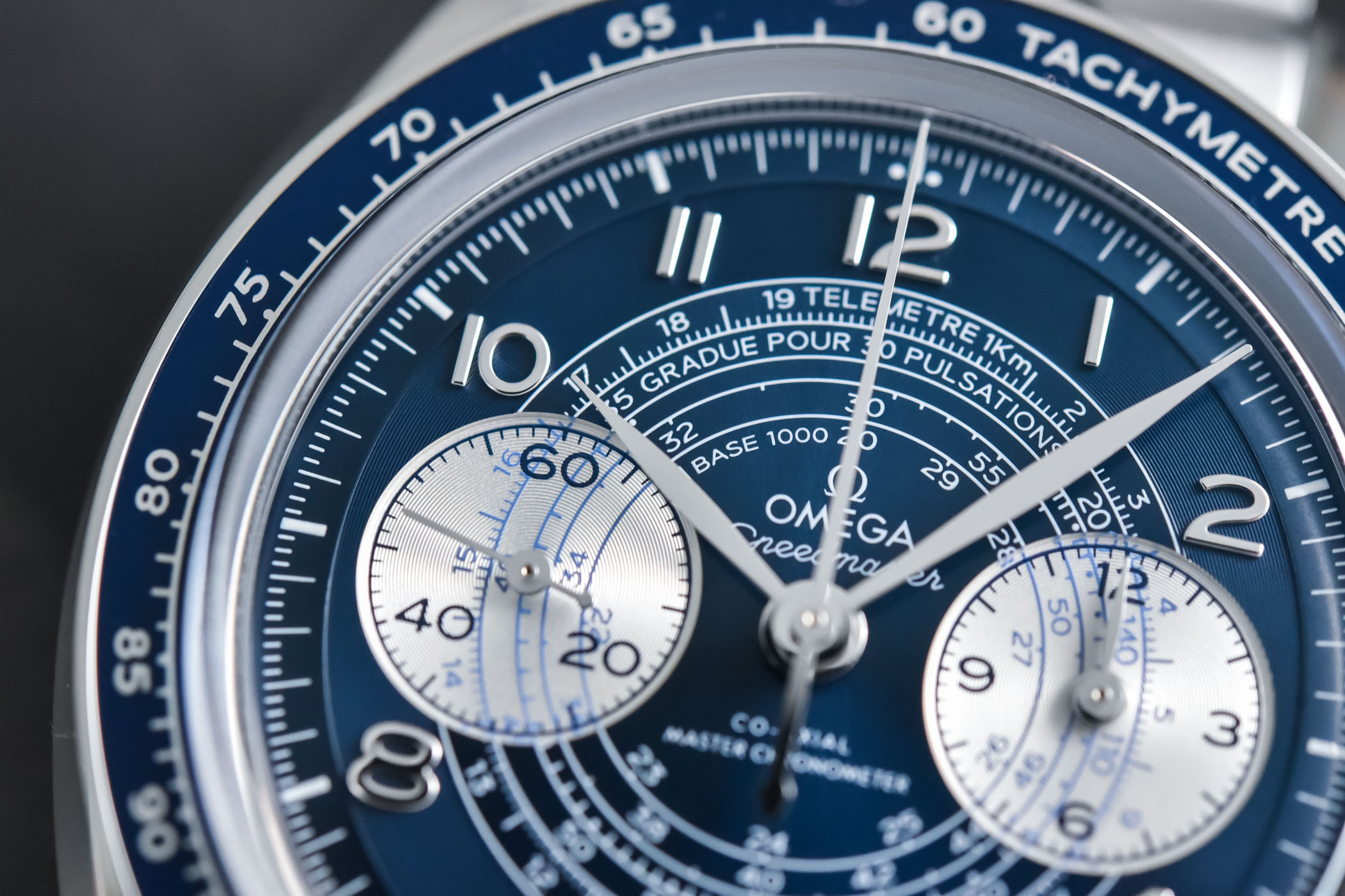



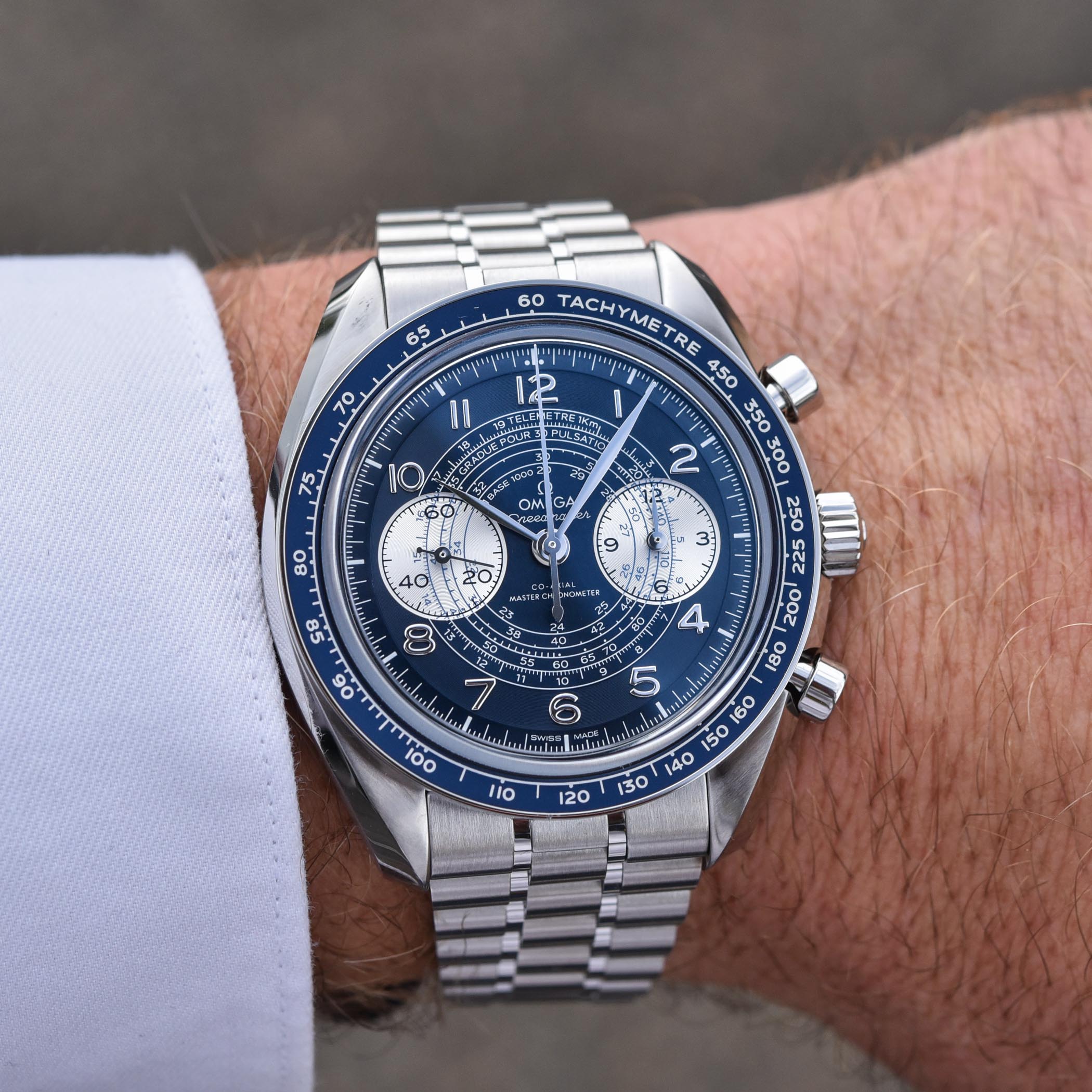
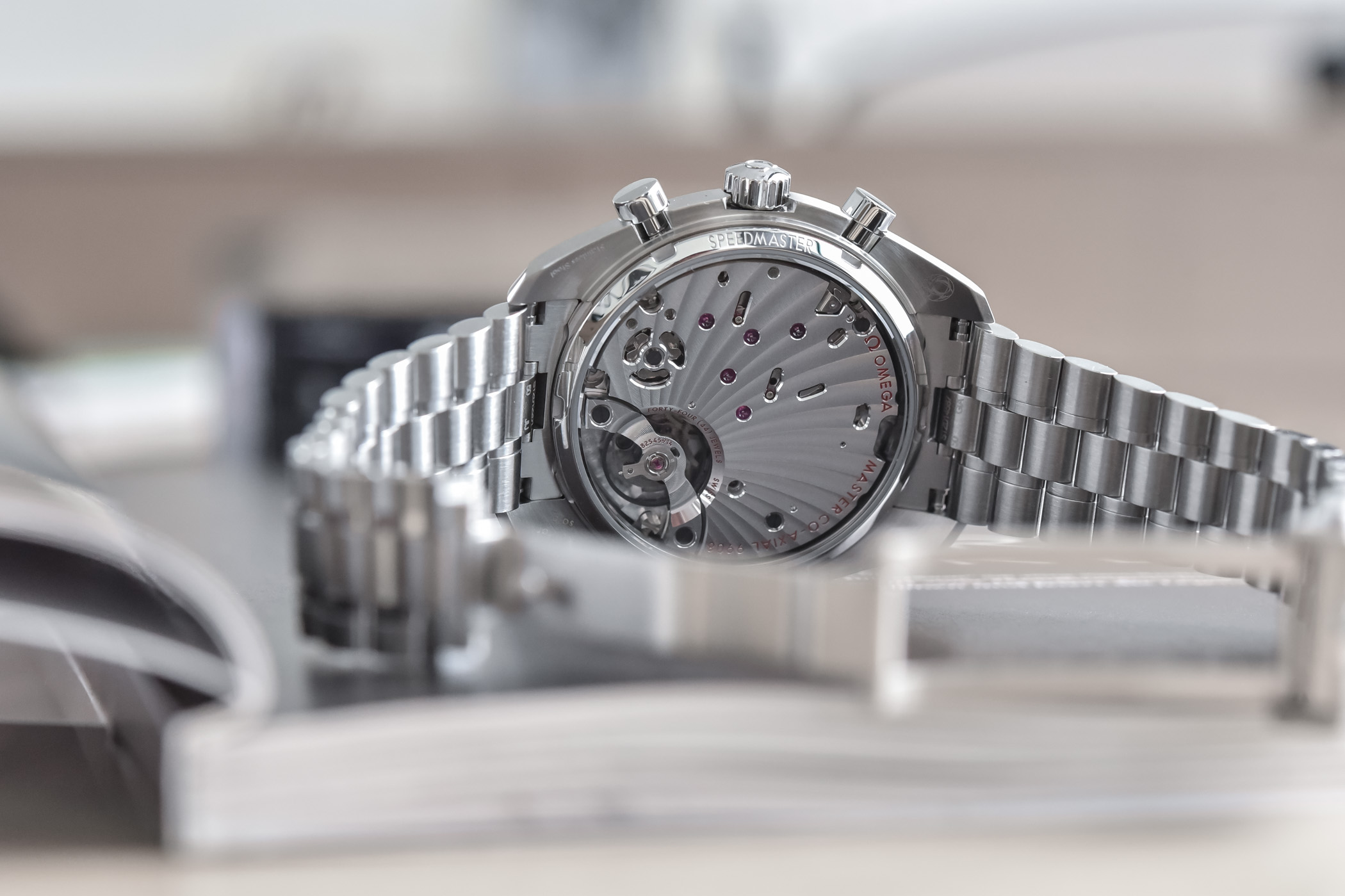

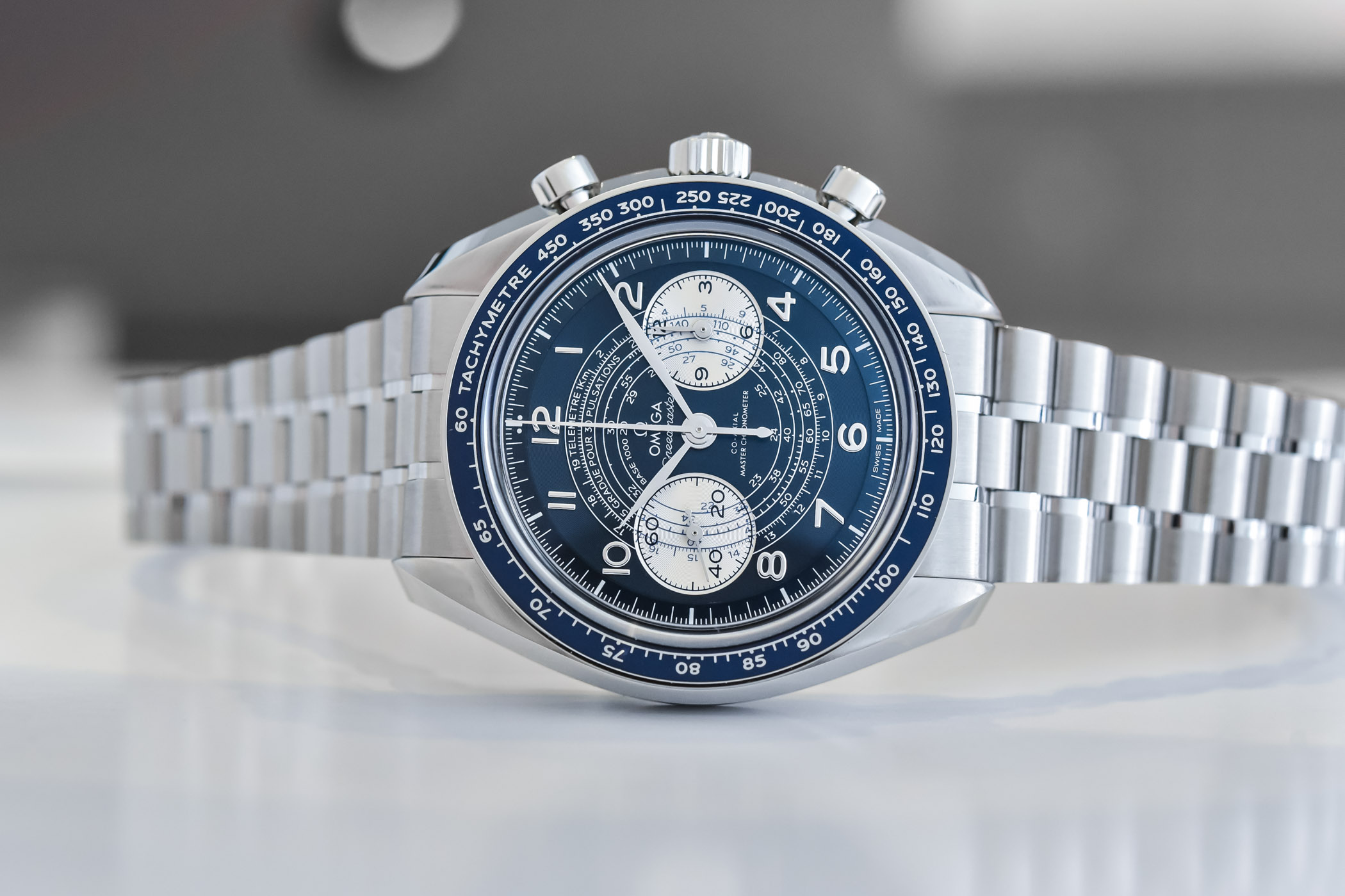

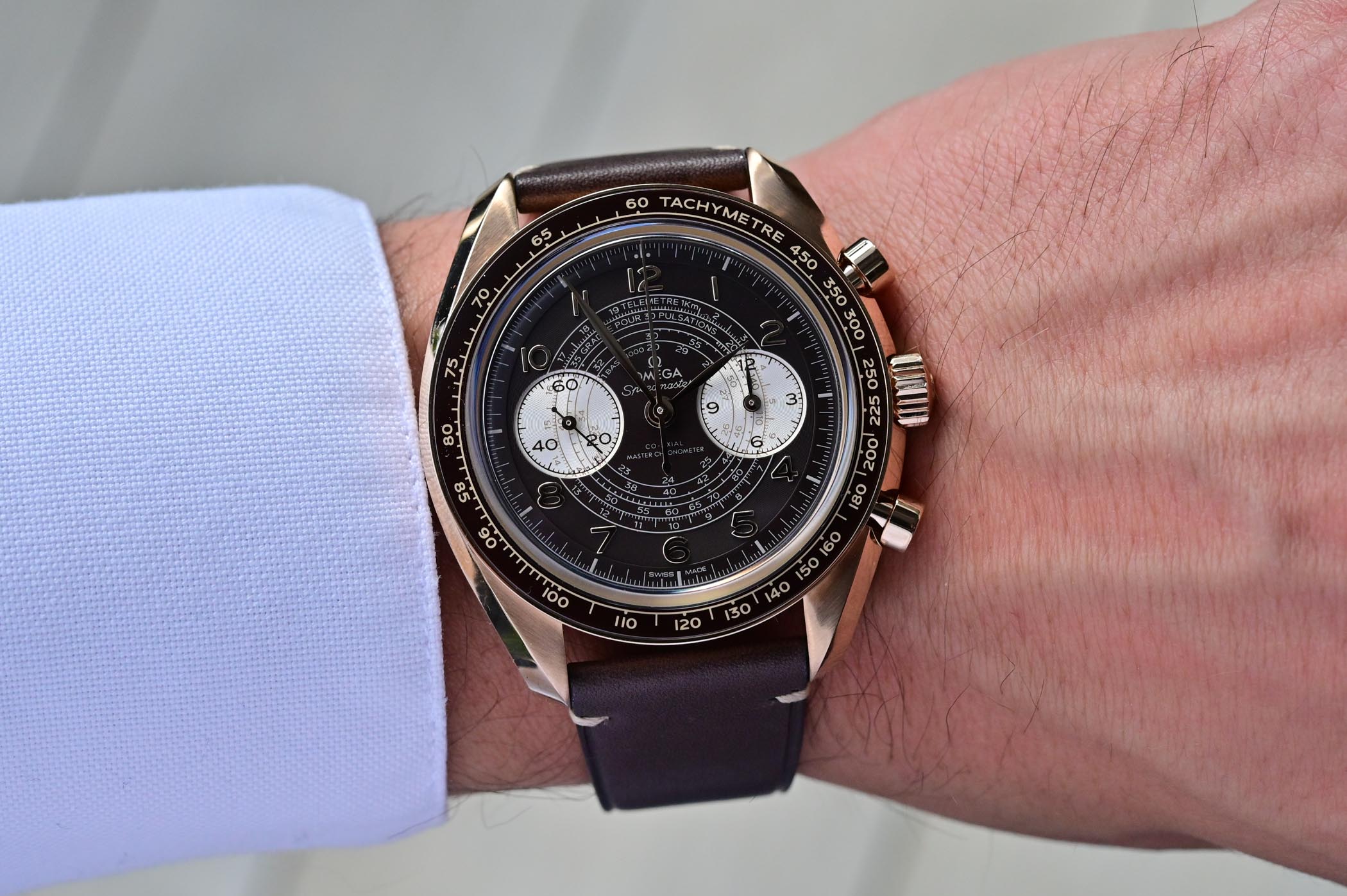
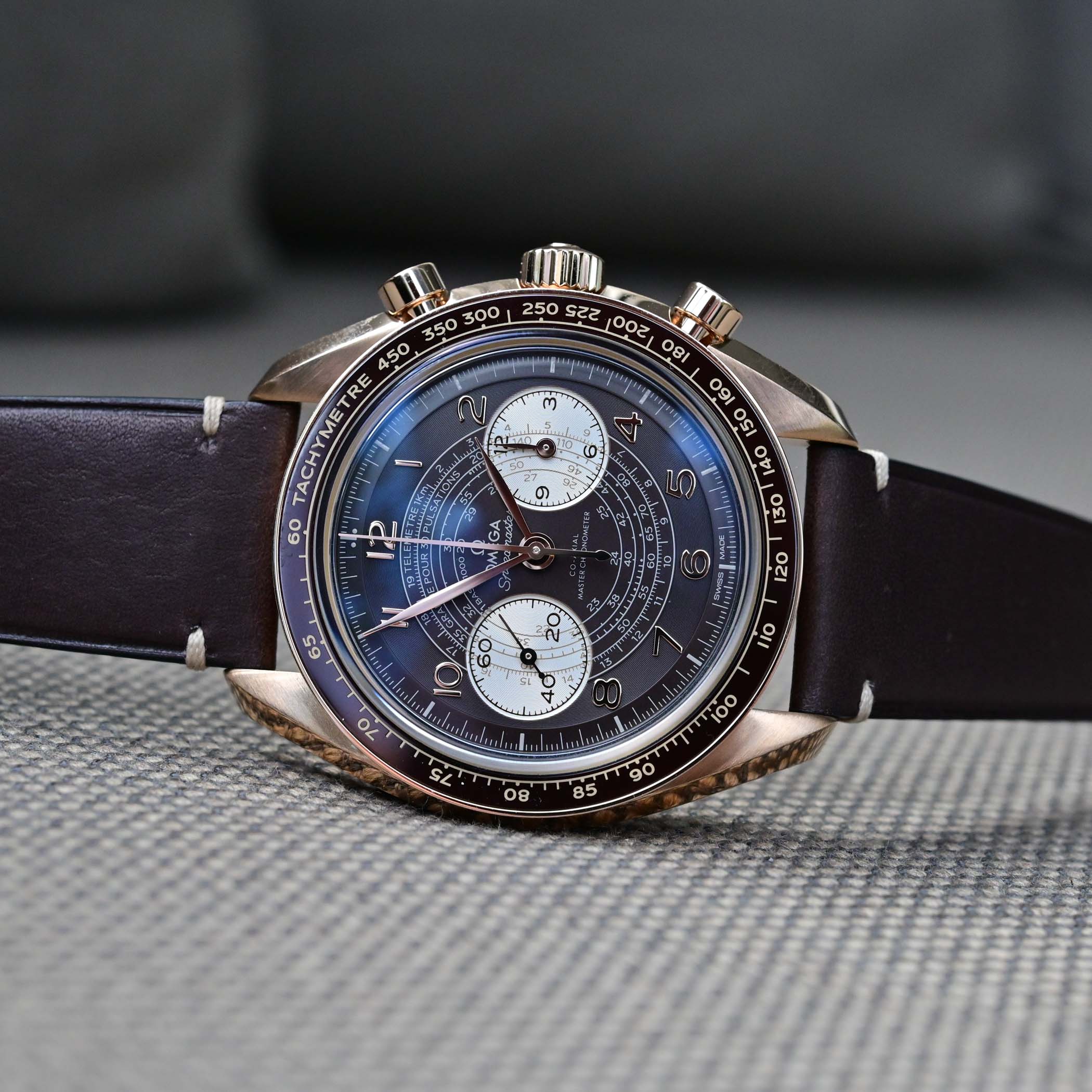
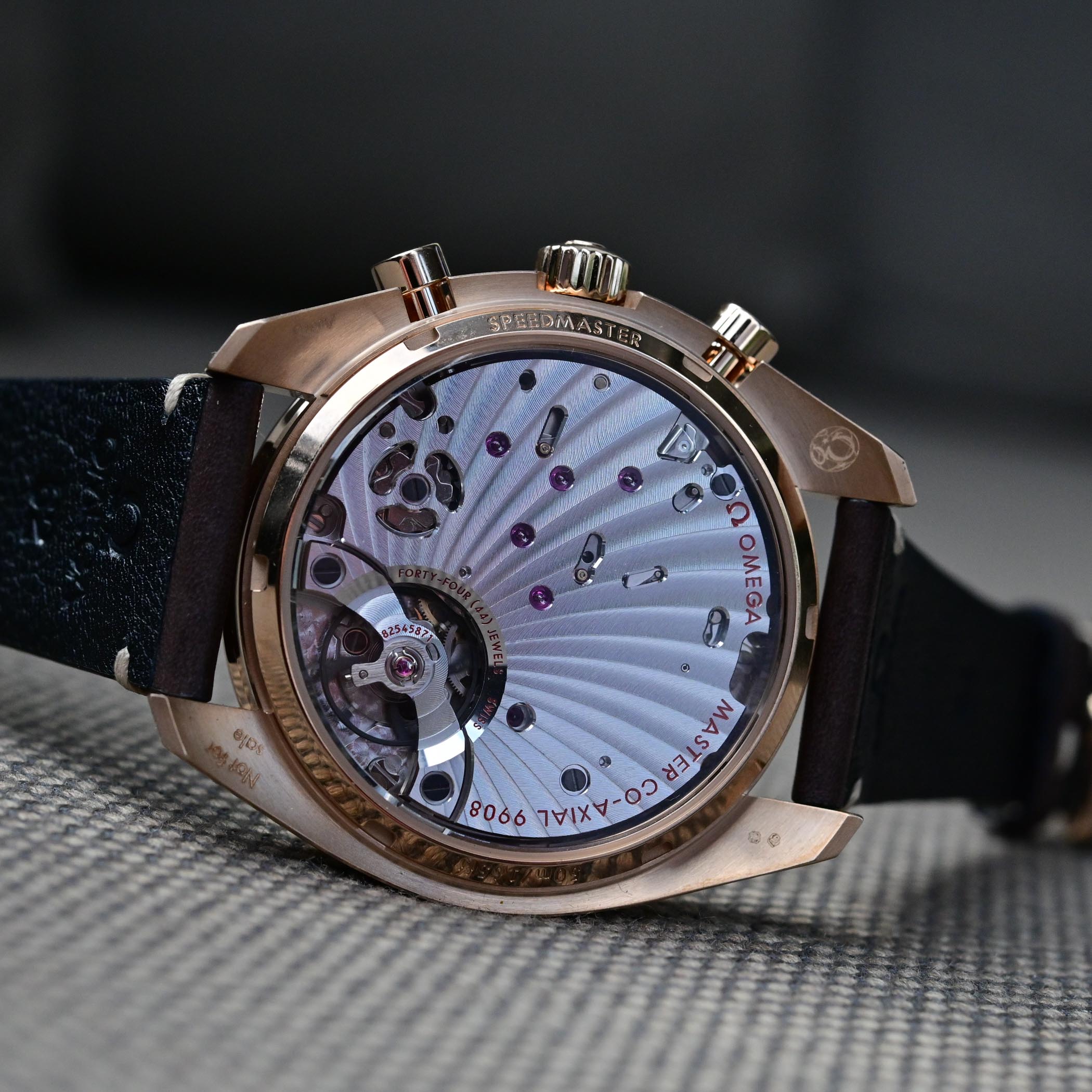



7 responses
Thank you for a very comprehensive, well written and erudite report on this new Speedmaster. As always Monochrome is first to “press” (internet?) with a new Omega. I have been waiting for this watch for a while as I heard several rumours about a new Speedmaster release.
I really like the movement, it looks stunning!! Not so sure about the dial, though. The Speedmaster case is such an iconic design that this new dial variant looks totally disruptive … and not in a good way. But maybe this is just me being myopic … 😉
Glad it has a full numeral 6 and not one that is cut off.
https://www.youtube.com/watch?v=NH9t44iOiA4
So, now the dust has settled a bit open this new Speedmaster and there are lots of photographs of actual watches as opposed to Omega’s over rendered publicity shots there are a couple of things I have noticed and it might be that Monochrome can confirm some of them at a later date with a hands on review. First, the case seems to be an amalgam of the new Speedmaster Professional Master Chronometer case on top with a case back very closely related to the Speedmaster Racing Master Choronometer of 2017. The very good photographs on Monochrome show a Speedmaster Professional style “cut out” in the case band for the crown whereas the Speedmaster Racing and Speedmaster Moonphase (the other two so-called “Two Counter” Speedmasters have a slightly more elaborate curved aperture for the crown. The crown and pushers seem to be directly lifted from or based on the Speedmaster Professional Master Chronometer versions and do not have the serrated stem underneath the pushers as on the other “Two Counter” Speedmaster models (or the old Speedmaster Moonwatch Co-axial Cal.9300.
The next thing I have noticed is that the dial very closely follows the Omega De Ville style of a “two zone” dial, meaning a central part with (usually) a “sunburst” brushed effect and an outer part with (usually) a concentric ring either matte brushed or grained. I may be wrong but it could be that Omega’s original plan was for another De Ville Chronoscope but at some point it was decided to use the Speedmaster as a base instead. Perhaps because the last De Ville Co-Axial Chronograph Cal.9300 was not a big seller and the Speedmaster is a reliable commercial piece. In fact a comparison with both the older De Ville Chronoscopes and the new De Ville Co-Axial Chronograph would be very interesting.
There have been comments that the dial is too busy or not appropriate for a “sports” watch like the Speedmaster but Omega’s own Museum range has two examples of very similar dials on two completely different watches. The Museum Collection No.3 Officers Watch 1945 and the Museum Collection Number 9 Milestone 1941 share almost the same tachymetre, telemetre, pulsometer dial but one is very definitely a “military field” watch (the ultimate type of “sports watch perhaps) and the other is a white gold dress piece. So my final point would be that until one has held the watch and worn it, played with the functions and so on it is too early to reach firm conclusions. I expect Frank and Brice and the team will help out with that.
where does this watch fit into.. big like a sports watch, but no Lume? Dress watch, too big?
@SPQR – interesting comment. And a long one. As for the case, it’s becoming too precise to answer properly, since we had a relatively short amount of time with the watches. It will require us to have one at the office for a review, in order to give you a proper answer. But you might be right.
As for the launch first in the DeVille collection, from what I’ve understood talking with the Omega team, it is that it has always been intended to be in the Speedy case, because that’s the chronograph vehicle for Omega. And yes, the dial has a two-tone finishing.